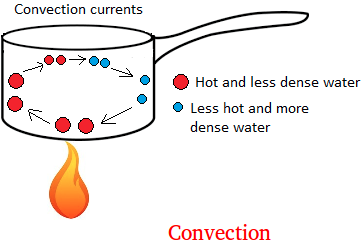Examples of convection
Below are some examples of convection. These examples will clearly
illustrate what convection is with situations you experience daily in
life. You will also understand what convection currents are as well.
Convection occurs only in fluids such as liquid or gas. Convection is a transfer of heat by a heated substance to a cooler region. The cooler region is usually located higher than the warmer region.
An easy example of convection is when you use radiators to heat your house during a cold winter. The heat coming out of the radiators usually came from hot water from the basement below.
When a fluid such as water or air is heated, it expands and becomes less dense. As a result, it rises.
More examples of convection
Boiling water in a cooking pot is also a great example of convection.
When you boil water, the liquid moves around quickly. Ever wondered why? Water at the bottom of the pan receives more heat. This will make the water at the bottom of the pan less dense and rise to the top. Once on top, it receives less heat and become more dense. This will make the water go back to the bottom of the pot again. Once at the bottom, it will go right back up, and the process repeats. The back and forth movements are called convection currents.
The process is illustrate below.

Notice the use of the big red circles to show that when water is heated, it will expand and become less dense.
We can also see convection currents in action at the seashore.
During the day, the shore will get warmer faster than the water. Recall that water has a high specific heat capacity, so it will take the water a long time to warm up.
Therefore, the air above the water is colder than the air above the shore. Since the air above the shore is warmer, it will rise and cooler air from the water will take its place. The result is that people at the shore feel a nice breeze on their face.
At night, the water is finally warmed up. Again, because of the high specific heat of water, it will take the water longer to cool down.
Therefore, the shore cools off more quickly. The warmer air is now over the sea. It is the sea that is now receiving a breeze.